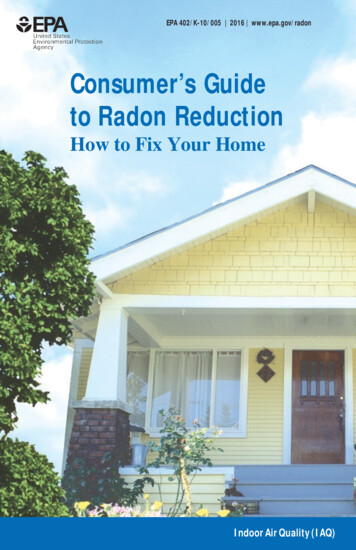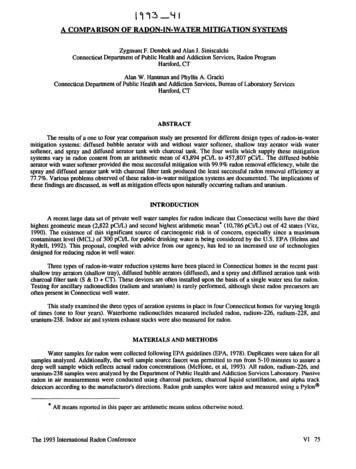
Transcription
EPA 402/K-10/005 2016 www.epa.gov/radonConsumer’s Guideto Radon ReductionHow to Fix Your HomeIndoor Air Quality (IAQ)
OVERVIEWReduce Radon Levels in Your HomeRadon is the leading cause of lung cancer for non-smokers and thesecond leading cause of lung cancer for the general population. TheSurgeon General and EPA recommend testing for radon and reducingradon in homes that have high levels. Fix your home if your radon levelis confirmed to be 4 picocuries per liter, pCi/L, or higher. Radon levelsless than 4 pCi/L still pose a risk, and in many cases may be reduced.If you smoke and your home has high radon levels, your risk of lungcancer is especially high.Select a State Certified and/or Qualified Radon MitigationContractorChoose a qualified radon mitigation contractor to fix your home. Start bychecking with your state radon office. Many states require radonprofessionals to be licensed, certified, or registered. You also can contactprivate radon proficiency programs for lists of privately certified radonprofessionals in your area. See pages 4 and 17 for more information.Radon Reduction Techniques W orkRadon reduction systems work. Some radon reduction systems canreduce radon levels in your home by up to 99 percent. Most homes canbe fixed for about the same cost as other common home repairs. Yourcosts may vary depending on the size and design of your home andwhich radon reduction methods are needed. Get an estimate from one ormore qualified radon mitigation contractors. Hundreds of thousands ofpeople have reduced radon levels in their homes.Maintain Your Radon Reduction SystemMaintaining your radon reduction system takes little effort and keeps thesystem working properly and radon levels low. See page 13 for moreinformation.A Consumer’s Guide to Radon Reduction
TINTRODUCTIONhis booklet is for people who tested their home for radon andhave elevated radon levels — 4 pCi/L or higher. This booklet canhelp you: Select a qualified radon mitigation contractor to reduce the radonlevels in your home. Determine an appropriate radon reduction method. Maintain your radon reduction system.Your state radon office can provide information on how to test your home or howto locate a qualified radon professional cal-radon-zones-and-state-contact-information. EPA’s ACitizen’s Guide to Radon and The Home Buyer’s and Seller’s Guide to Radonhave information on radon testing. Both documents are available on.www.epa.gov/radon3
HOW RADON ENTERS YOUR HOMERadon is a naturally occurringradioactive gas produced by thebreakdown of uranium in soil, rock,and water. Air pressure inside your home isusually lower than pressure in the soilaround your home’s foundation. Because ofthis difference in pressure, your home actslike a vacuum, drawing radon in throughfoundation cracks and other openings.Radon also may be present in well waterand can be released into the air in yourhome when water is used for showering andother household uses. In most cases, radonentering the home through water is a smallrisk compared with radon entering yourhome from the soil. In a small number ofhomes, the building materials — such asgranite and certain concrete products— can give off radon, although building materials rarely cause radon problems bythemselves. In the United States, radon gas in soils is the principal source ofelevated radon levels in homes.RADON IS A CANCER-CAUSING,RADIOACTIVE GASRadon is estimated to cause tens of thousands of lung cancer deaths eachyear. In fact, the Surgeon General has warned that radon is the secondleading cause of lung cancer in the United States. Only smoking causesmore lung cancer deaths. If you smoke and your home has high radon levels,your risk of lung cancer is especially high.WHAT DO YOUR RADON TEST RESULTS MEAN?Any radon exposure has some risk of causing lung cancer. The lower theradon level in your home, the lower your family’s risk of lung cancer.The amount of radon in the air is measured in pCi/L.2A Consumer’s Guide to Radon Reduction
The U.S. Congress has set a long-termgoal that indoor radon levels be nomore than outdoor levels; about 0.4pCi/L of radon is normally found in theoutside air. EPA recommends fixingyour home if the results of one longterm test or the average of two shortterm tests show radon levels of 4 pCi/Lor higher. With today’s technology,radon levels in most homes can bereduced to 2 pCi/L or below. You alsomay want to consider fixing if the levelis between 2 and 4 pCi/L.A short-term test remains in your homefor two days to 90 days, whereas along-term test remains in your homefor more than 90 days. All radon testsshould be taken for a minimum of48 hours. A short-term test will yieldfaster results, but a long-term test willgive you a better understanding ofyour home’s year-round average radonlevel.SELECTING A RADONTEST KITSince you cannot see or smell radon,special equipment is needed to detectit. When you’re ready to test yourhome, contact your state radon officefor information on locating qualifiedtest kits or qualified radon testers. Youalso can order test kits and obtaininformation at http://sosradon.org/There are two types of radon testingdevices. Passive radon testing devicesdo not need power to function. Theseinclude charcoal canisters, alpha-trackdetectors, charcoal liquid scintillationdevices, and electret ion chamberdetectors. Both short- and long-termpassivedevicesaregenerallyinexpensive. Active radon testingdevices require power to function andusually provide hourly readings and anaverage result for the test period. Theseinclude continuous radon monitors andcontinuous working level monitors, andthese tests may cost more. A state orlocal official can explain the differencesbetween the devices and recommendones that are most appropriate for yourneeds and expected testing conditions.Make sure to use a radon testing devicefrom a qualified laboratory.EPA recommends two categories ofradon testing. One category is forconcerned homeowners or occupantswhose home is not for sale; refer toEPA’s pamphlet “A Citizen’s Guideto Radon” for testing guidance. Thesecond category is for real estatetransactions; refer to EPA’s pamphlet“Home Buyer’s and Seller’s Guide toRadon,” which provides guidance andanswers to some common questions.Both documents are available at .www.epa.gov/radon3
WHY HIRE A CONTRACTOR?EPA recommends that you have a qualified radon mitigation contractor fixyour home because lowering high radon levels requires specific technicalknowledge and special skills. Without the proper equipment or technicalknowledge, you could actually increase your radon level or create other potentialhazards and additional costs. However, if you decide to do the work yourself, getinformation on appropriate training courses from your state radon office.WILL ANY CONTRACTOR DO?EPA recommends that you use a certified or qualified radon mitigationcontractor trained to fix radon problems. You can determine a serviceprovider’s qualifications to perform radon measurements or to mitigate yourhome in several ways. First, check with your state radon office. Many statesrequire radon professionals to be licensed, certified or registered, and to installradon mitigation systems that meet state requirements. Most states can provideyou with a list of knowledgeable radon service providers doing business in thestate local-radon-zones-andstate-contact-information).In states that don’t regulate radon services, ask the contractor if they hold aprofessional proficiency or certification credential, and if they follow industryconsensus standards, such as the American Society for Testing and Materials,ASTM, Standard Practice for Installing Radon Mitigation Systems in ExistingLow-Rise Residential Buildings, E2121. You can contact private proficiencyprograms for lists of privately certified professionals in your area. Suchprograms usually provide members with a photo ID card, which indicates theirqualifications and the ID card’s expiration date. For more information on privateproficiency programs, visit asurement-and-mitigation-professional#what, or contact your state radonoffice.HOW TO SELECT A CONTRACTORGet EstimatesChoose a contractor to fix a radon problem just as you would choose someoneto do other home repairs. It is wise to get more than one estimate, to ask forreferences, and to contact some of those references to ask if they are satisfiedwith the contractor’s work. Also, ask your state radon office or your county orstate consumer protection office for information about the contractors.4A Consumer’s Guide to Radon Reduction
Use this checklist when evaluating and comparing contractors and ask thefollowing questions:YES NO Will the contractor provide references or photographs, as well as test resultsof before and after radon levels of past radon reduction work? Can the contractor explain what the work will involve, how long it will taketo complete, and exactly how the radon reduction system will work? Does the contractor charge a fee for any diagnostic tests? Although manycontractors give free estimates, they may charge for diagnostic tests. Thesetests help determine what type of radon reduction system should be used andin some cases are necessary, especially if the contractor is unfamiliar with thetype of house structure or the anticipated degree of difficulty. See “RadonReduction Techniques” on page 8 for more on diagnostic tests. Did the contractor inspect your home’s structure before giving you anestimate? Did the contractor review the quality of your radon measurement results anddetermine if appropriate testing procedures were followed?Compare the contractor’s proposed costs and consider what you get for yourmoney, taking into account: a less expensive system may cost more to operateand maintain; a less expensive system may have less aesthetic appeal; a moreexpensive system may be best for your home; and, the quality of the buildingmaterial will affect how long the system lasts.Do the contractors’ proposals and estimates include:YES NO Proof of state certification, professional proficiency or certificationcredentials? Proof of liability insurance and being bonded, and having all necessarylicenses to satisfy local requirements? Diagnostic testing prior to design and installation of a radon reductionsystem? Installation of a warning device to caution you if the radon reduction systemis not working correctly? Testing after installation to make sure the radon reduction system workswell? A guarantee to reduce radon levels to 4 pCi/L or below? And if so, for howlong?www.epa.gov/radon5
The ContractAsk the contractor to prepare a contract before any work starts. Read the contractbefore you sign it. Make sure everything in the contract matches the originalproposal. The contract should describe exactly what work will be done prior toand during the installation of thesystem, what the system consistsof, and how the system willoperate. Many contractors providea guarantee that they will adjustor modify the system to reacha negotiated radon level (e.g., 2pCi/L or less). Carefully read theconditions of the contract describingthe guarantee. Consider optionaladditions to your contract thatmay add to the initial cost of the system, but may be worth the extra expense.Typical options might include an extended warranty, a service plan or improvedaesthetics.Important information that should appear in the contract includes:6 The total cost of the job, including all taxes and permit fees; howmuch, if any, is required for a deposit; and when payment is due infull. The time needed to complete the work. A statement that the contractor carries liability insurance and isbonded and insured to protect you in case of injury to persons, ordamage to property, while the work is being done. A guarantee that the contractor will be responsible for damage duringthe job and cleanup after the job. Details of any guarantee to reduce radon below a negotiated level. A declaration stating whether any warranties or guarantees aretransferable if you sell your home. A description of what the contractor expects the homeowner to do,such as make the work area accessible, before work begins.An agreement by the contractor to obtain necessary permits andfollow required building codes.Details of warranties or other optional features associated with thehardware components of the mitigation system.A Consumer’s Guide to Radon Reduction
WHAT TO LOOK FOR IN A RADONREDUCTION SYSTEMIn selecting a radon reduction method for your home, you and your contractorshould consider several things, including: how high your initial radon levelis, the costs of installation and system operation, your home size, and yourfoundation type.Installation andOperating CostsMost types of radon reduction systemscause some loss of heated or airconditioned air, which could increaseyour utility bills. How much yourutility bills increase will depend onthe climate you live in, what kind ofreduction system you select, and howyour home is built. Systems that usefans are more effective in reducingradon levels; however, they willslightly increase your electric bill.www.epa.gov/radon7
RADON REDUCTION TECHNIQUESThere are several methods a contractorcan use to lower radon levels in yourhome. Some techniques prevent radonfrom entering your home while othersreduce radon levels after it has entered. EPAgenerally recommends methods that preventthe entry of radon. Soil suction, for example,prevents radon from entering your home bydrawing the radon from below the home andventing it through a pipe, or pipes, to the airabove the home where it is quickly diluted.Any information that you may have aboutthe construction of your home could helpyour contractor choose the best system. Yourcontractor will perform a visual inspection of your home and design a systemthat considers specific features of your home. If this inspection fails to provideenough information, the contractor may need to perform diagnostic tests duringthe initial phase of the installation to help develop the best radon reductionsystem for your home. For instance, your contractor can use chemical smoke tofind the source and direction of air movement. A contractor can learn air flowsources and directions by watching a small amount of smoke that he or she shotinto holes, drains, sumps or along cracks. The sources of air flow show possibleradon routes. A contractor may have concerns about backdrafting of combustionappliances when considering radon mitigation options, and may recommend thatthe homeowner have the appliances checked by a qualified inspector.Another type of diagnostic test is a soil communication test. This test uses avacuum cleaner and chemical smoke to determine how easily air can move fromone point to another under the foundation. By inserting a vacuum cleaner hosein one small hole and using chemical smoke in a second small hole, a contractorcan see if the smoke is pulled down into the second hole by the force of thevacuum cleaner’s suction. Watching the smoke during a soil communication testhelps a contractor decide if certain radon reduction systems would work well inyour home.Whether diagnostic tests are needed is decided by details specific to your home,such as the foundation design, what kind of material is under your home, and bythe contractor’s experience with similar homes and similar radon test results.8A Consumer’s Guide to Radon Reduction
Home Foundation TypesYour home type will affect the kind of radon reduction system that will workbest. Homes are generally categorized according to their foundation design.For example: basement; slab-on-grade, concrete poured at ground level; orcrawlspace, a shallow unfinished space under the first floor. Some homes havemore than one foundation design feature. For instance, it is common to havea basement under part of the home and to have a slab-on-grade or crawlspaceunder the rest of the home. In these situations, a combination of radon reductiontechniques may be needed to reduce radon levels to below 4 pCi/L.Radon reduction systems can be grouped by home foundation design. Find yourtype of foundation design above and read about which radon reduction systemsmay be best for your home.Basement and Slab-on-Grade HomesIn homes that have a basement or a slab-on-grade foundation, radon is usuallyreduced by one of four types of soil suction: subslab suction, drain-tile suction,sump-hole suction, or block-wall suction.Active subslab suction — also calledsubslab depressurization — is the mostcommon and usually the most reliableradon reduction method. One or moresuction pipes are inserted through thefloor slab into the crushed rock or soilunderneath. They also may be insertedbelow the concrete slab from outside thehome. The number and location of suctionpipes that are needed depends on howeasily air can move in the crushed rockor soil under the slab and on the strengthof the radon source. Often, only a singlesuction point is needed.www.epa.gov/radon9
A contractor usually gets this information from visual inspection, from diagnostictests or from experience. A radon vent fan connected to the suction pipes drawsthe radon gas from below the home and releases it into the outdoor air whilesimultaneously creating a negative pressure or vacuum beneath the slab. Commonfan locations include unconditioned home and garage spaces, including attics andthe exterior of the home.Passive subslab suction is the same as active subslab suction except it relies onnatural pressure differentials and air currents instead of a fan to draw radon upfrom below the home. Passive subslab suction is usually associated with radonresistant features installed in newly constructed homes. Passive subslab suctionis generally not as effective in reducing high radon levels as active subslabsuction.Some homes have drain tiles or perforated pipe to direct water away fromthe foundation of the home. Suction on these tiles or pipes is often effective inreducing radon levels.One variation of subslab and drain tile suction is sump-hole suction. Often, whena home with a basement has a sump pump to remove unwanted water, the sumpcan be capped so that it can continue to drain water and serve as the location for aradon suction pipe.Block-wall suction can be used in basement homes with hollow block foundationwalls. This method removes radon and depressurizes the block wall, similar tosubslab suction. This method is often used in combination with subslab suction.Crawlspace HomesAn effective method to reduce radon levels in crawlspace homes involvescovering the earth floor with a high-density plastic sheet. A vent pipe and fan areused to draw the radon from under the sheet and vent it to the outdoors. This formof soil suction is called submembrane suction, and when properly applied isthe most effective way to reduce radon levels in crawlspace homes. Anotherless-favorable option is active crawlspace depressurization, which involvesdrawing air directly from the crawlspace using a fan. This technique generallydoes not work as well as submembrane suction and requires special attention tocombustion appliance backdrafting and sealing the crawlspace from other portionsof the home. It also may result in increased energy costs due to loss of conditionedair from the home.In some cases, radon levels can be lowered by ventilating the crawlspacepassively, or actively, with the use of a fan. Crawlspace ventilation may lowerindoor radon levels both by reducing the home’s suction on the soil and bydiluting the radon beneath the home. Passive ventilation in a crawlspace is10A Consumer’s Guide to Radon Reduction
achieved by opening vents or installing additional vents. Activ
reduce radon levels in your home by up to 99 percent. Most homes can be fixed for about the same cost as other common home repairs. Your costs may vary depending on the size and design of your home and which radon











